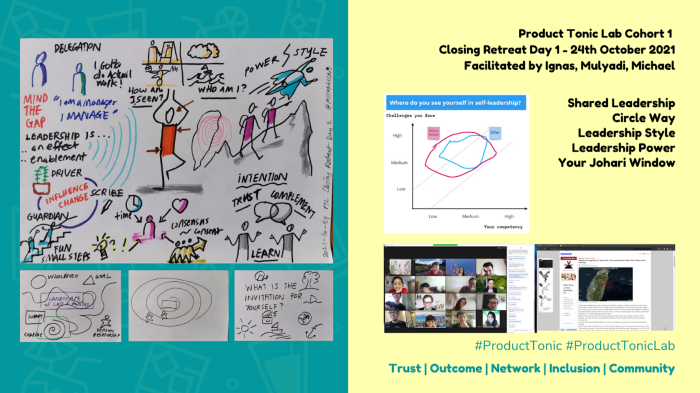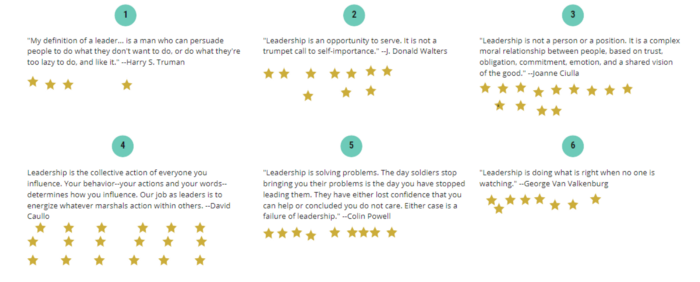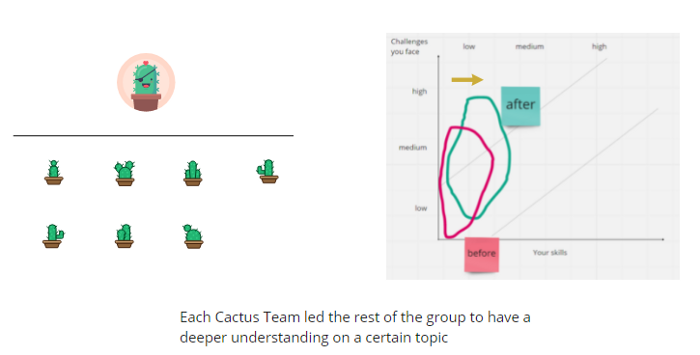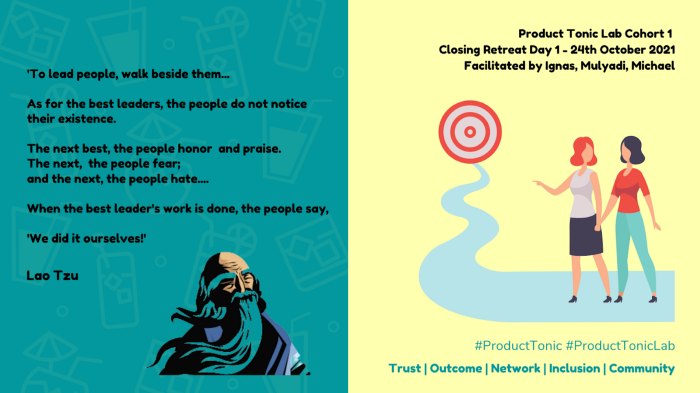PTL Closing Retreat - Part 1
Knowing your Self in Leadership

The closing retreat is designed to close off learning backlog items uncovered from previous meetup 10 (Inviting Leadership in Yourself) and expand our self-awareness using the Johari Window model.
- Understanding the leadership concept in general
- Increase the awareness of one’s leadership power and style by getting feedback from our own Cactus (i.e. Meetup) Team
- Increase the awareness of one’s self leadership, specifically power and style
Sunday Mindful Yoga with Teresa Thuy Pham
It is said that: “When you can control the body, you can control the mind.”
We started with Sunday Mindful Yoga with Teresa Thuy — a series of yoga movements designed to explore, establish, and bolster our mind and body connection awareness. Reflecting back, following articles helps me better understand about the purpose and benefit of the activity:
Mindfulness is a way of training yourself to simply focus on whatever is happening in the present moment…with Mindful Yoga, the main focus is on mind-body awareness, as opposed to alignment details and the exact physical posture… (It) places great importance on observing your mind and feelings while you are acting out the yoga pose - Ref
Positioning your body in certain ways can have immediate effects on your mental and emotional state. Being aware of your body language and what it reveals about your attitudes and feelings can help you to change your attitudes and feelings just by changing your physical posture - Ref
The body senses rather than thinks…The body scan teaches us how to lean gently into discomfort… (which) reduces the unwelcome sensations’ power to derail us. By paying attention to body sensations, and noticing what arises in awareness, we incline our interest into being alive, not as a set of philosophical ideas, but as actual phenomena — the very experience of things. This enables us to tune into the actuality of moment-by-moment living, generating appreciation that can nurture a sense of awe and gratitude - Ref
Knowing your Self in Leadership with Mulyadi & Ignatius
In “Where do you see yourself in self-leadership”, we re-visited concepts introduced in the opening retreats and identified leadership concepts that resonate with us the most.

There are quite diverse definitions that resonate with the cohort:
“Leadership is the collective action of everyone you influence. Your behavior — your actions and your words — determines how you influence. Our job as leaders is to energize whatever marshals action within others.” — David Caullo
“Leadership is not a person or a position. It is a complex moral relationship between people, based on trust, obligation, commitment, emotion, and a shared vision of the good.” — Joanne Ciulla
“Leadership is an opportunity to serve. It is not a trumpet call to self-importance.” — J. Donald Walters
“Leadership is solving problems. The day soldiers stop bringing you their problems is the day you have stopped leading them. They have either lost confidence that you can help or concluded you do not care. Either case is a failure of leadership.” — Colin Powell
“Leadership is doing what is right when no one is watching.” — George Van Valkenburg
“A man who can persuade people to do what they don’t want to do, or do what they’re too lazy to do, and like it.” — Harry S. Truman
The group noted Leadership is not just about making right decisions but also about enablement — creating safe space for others to make decisions. As one participant put it : “leadership as an effect, and causing a ripple effect in everyone you influence, be it good or bad”
Aspect of Leadership Practice
During PTL we explored 2 practice of Leadership: Shared Leadership and Rotating Leadership
Shared Leadership

In this “Shared Leadership” model, the formal leadership role remains usually with one person in charge (e.g. the manager or team lead). Members are empowered to actively take actions to remove obstacles or seek opportunities. Shared leadership allows us to learn and complement each other. The group shared stories around constraints of time, ideas, doubts and moving from consensus to consent, making things fun and taking little steps to achieve each meetup. Some tips / lesson learned from how did the cohort practice shared leadership — their decision making process and challenges when designing and/or delivering the meetup:
- Open communication
- Celebrate small victories
- Democratic; recognise each other’s strength
- Common time — schedule ahead (responsibility to make meetup work)
Rotating Leadership

“Rotating Leadership” is one of 3 principles of “Circle Way” (i.e. technique PTL practiced to enable intentional and safe space for group interactions). Here, the formal leadership role rotates among the members, alternating decision control between partners to access their complementary capabilities. This allows team members to become leaders and experiment with new things and pick up new skills on the go.
The rotating leadership is being practiced through meetups organised by the “PTL Cactus team”. Each cactus team leads the cohort in exploring topics across Product Leadership / Decisions / Trust / Sustainability / Resilience / Mentorship / Ownership / Culture / Economy / Self providing an opportunity to design/influence change in the group.
Some observations from practicing “rotating leadership”:
- Can learn by observing and following — Allowing others to lead creates learning opportunities about how other people do it, their points of view and their styles
- Deepen and broaden team’s knowledge through different perspectives while reducing blind spot
- Uncovering complementary strength of everyone in the team.
- Trust people to lead and give everyone opportunities to lead so they grow
- Great to empower and delegate, so that everyone can build new skills
Leadership Power and Styles

Having completed the journey of leading and organising meetups as team, we revisit understanding of ourselves in :
- Leadership Power : Coercive, Reward, Legitimate, Expert, Referent, Information, Charismatic, Moral and
- Leadership Style : Authoritarian, Participative, Delegative, Transactional, Transformational. Servant.
Power = a person’s ability to control activities of other individuals

Style = frameworks developed that describe main ways that people lead

We are invited in exercise to gather and compare our self-assessment with feedback from our peers — i.e. to see whether there’s a gap between how we see our leadership style and power and how others see it and help each other to deepen their understanding of their own leadership style and power.
Each cactus team is requested to reflect following question: How would you assess your own and your team members’ leadership style and power as meetup facilitators (when designing or delivering meetup)?

Here we are using “Johari Window” as psychological tool of soliciting, conveying and accepting feedback. With the help of such feedback, we can gain awareness of our positive and negative traits as perceived by others and better recognise issues that may inhibit team dynamics.
I found this exercise enriching and meaningful as it was given by fellow peers who has been journeying closely throughout PTL. Through the dialogue and sharing, we give and receive affirmation of our strengths and open up new work areas.
Following quote by Lao Tzu gave timely reminder and inspiration for role of leadership regardless of their preferred choice of power and styles, i.e. ability to encourage and inspire outstanding work in the team without taking any credit for themselves — finding pure satisfaction in the accomplishment of others.

What is the invitation for yourself?
We wrap up this Closing Retreat by spending time drawing together to conceptualise and declare leadership areas we aim to work on.
-
Step 1 — Draw a timeline / landscape of last 5 months
Use symbols e.g. Circle = Wholeness, Rectangle = Support, Triangle = Goal, Spiral = Change, Star person = wholeness
-
Step 2 — Zoom into a specific area
Draw deeper into what is emerging and add details
-
Step 3 — Looking at symbols that represent possibilities (e.g. Risk, Investment, Seed, Goals, Flow) and Think about your next step
What is the invitation you can draw and declare (assert) for yourself to work on yourself in Leadership?
